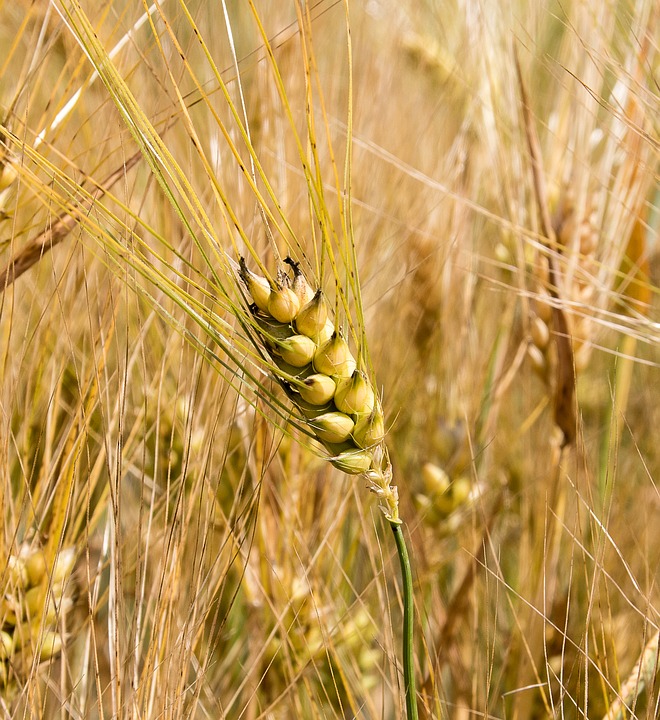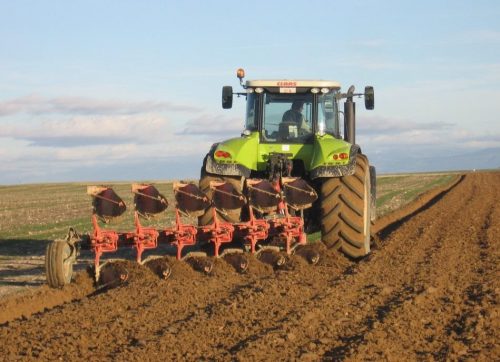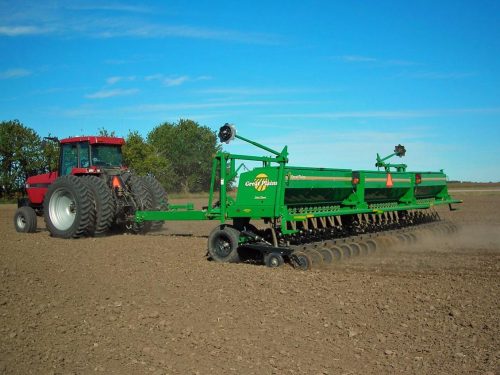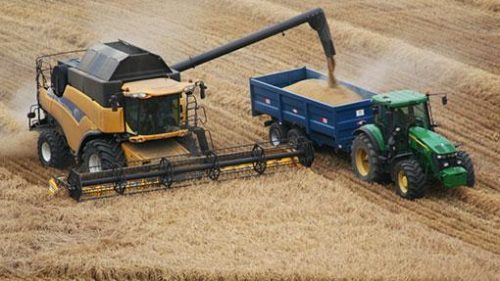Barley, cultivation and harvesting technology
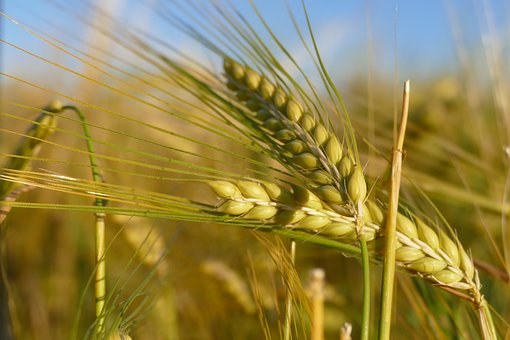
Barley (Hordeum vulgare) is one of the first crops. Historical sources show that the barley plant has been cultivated since the Stone Age, from the beginnings of agriculture. Barley is used in human nutrition, industry, and animal feed. Groats obtained from barley grains are used in the preparation of sauces, and if crushed, can be used in infant nutrition. Barley grains are a concentrated animal feed, very good for fattening animals. Barley bran contains over 120 grams of digestible proteins per kilogram. Barley straws have a higher nutritional value than wheat straws and have a high amount of fibers. Barley is also used in brewing. In this case, the plants must have a low protein content (this makes it difficult to clarify the beer) and a high starch content (which favorably influences the extraction of beer).
The stem has 5-7 internodes, and its height is 50-100 cm. The leaves are alternately arranged, one at each node. The ligule is reduced. The inflorescence is a spike, at each base of the rachis, there are three monofloral spikelets. The fruit is a caryopsis, and the root is fascicular.
Tillering and flowering
The tillering begins after the sprouting of the 3rd leaf and lasts about 2-3 weeks. The optimum tillering temperature is 8-12 degrees Celsius, and the ideal humidity is 60-80%. Autumn barley has a good tillering. During this process, each shoot forms its own roots, like wheat. To develop the straw and spike, barley must go through the vernalization stage (35-45 days at 1-3 degrees Celsius). Flowering takes place during spike development, and pollination takes place before the flowers open. The vegetative growth period of barley lasts 250-270 days. This period can be influenced by pedoclimatic factors.
Environmental and soil requirements
Barley is more sensitive to winter temperatures than wheat. It needs 1700-2100 degrees Celsius during the vegetative growth period. Due to the shorter vegetative growth period, barley avoids drought. It prefers permeable, fertile soils with a pH of 6.5-7.5.
Barley crop technology
Crop rotation
Barley has requirements similar to wheat regarding the preceding plant. To withstand well the winter, it needs to be harvested after early harvest plants. The best precursors are annual and perennial legumes, rapeseed, sunflower, corn, flax, autumn potato, or Sorghum Sudangrass.
Fertilization
The specific consumption of nutrients of barley is similar to that of wheat. It is recommended to carry out basic fertilization with an NPK fertilizer before preparing the seedbed. Doses are established according to soil supply with nutrients and fertilization from previous years. In autumn, it is not recommended to apply large amounts of nitrogen. Fertilization in stages should be done as early as possible, in late winter-early spring. At the same time, barley reacts favorably to the application of foliar fertilizers during the vegetative growth period.
Recommended products
-
You can find products on a different store
Change Store -
You can find products on a different store
Change Store -
You can find products on a different store
Change Store -
You can find products on a different store
Change Store -
You can find products on a different store
Change Store -
You can find products on a different store
Change Store -
You can find products on a different store
Change Store -
You can find products on a different store
Change Store -
You can find products on a different store
Change Store -
You can find products on a different store
Change Store -
You can find products on a different store
Change Store -
You can find products on a different store
Change Store -
You can find products on a different store
Change Store -
You can find products on a different store
Change Store -
You can find products on a different store
Change Store -
You can find products on a different store
Change Store -
You can find products on a different store
Change Store -
You can find products on a different store
Change Store -
You can find products on a different store
Change Store -
You can find products on a different store
Change Store -
You can find products on a different store
Change Store -
You can find products on a different store
Change Store -
You can find products on a different store
Change Store -
You can find products on a different store
Change Store
Field works
After harvesting the preceding crop, the plowing work has to be carried out. The aim is to grind the vegetal waste and mix it with the soil. This work also grinds the surface layer of the soil. Plowing has to be carried out immediately after stubbing out the field. If the soil moisture does not allow the plowing to be carried out in optimal conditions, you have to wait for significant rainfall first. If the environmental conditions do not improve, the plowing can be replaced with two works done with a disc harrow. The plowing depth is around 20 cm. The preparation of the seedbed must be done just before sowing with works carried out with the combine. The seedbed must be prepared well for the good development of the plants and for good resistance to winter conditions.
Seeds and sowing
The seed must have a purity of at least 98% and germination of over 90%. Seed treatments can be performed against diseases and pests, using specific products. The best time to sow is between September 15 and October 10. The sowing density is 450-500 germinable grains/square meter. The distance between the rows is 12.5 cm. The sowing depth is 3-5 cm. If sowing is done at greater depths, the plants will grow slowly, and if a crust is formed at the surface of the soil, the plants will not develop. The underground organs of barley have a low capacity to penetrate the soil. Due to this fact, the sowing has to be done at the optimal depth.
Diseases and pests
The main diseases that can affect barley crops are powdery mildew, barley stripe, net blotch, Fusariosis, Karnal bunt of wheat, rust, loose smut. Among the pests, the most common are sunn pest, shining leaf chafer, ground beetle, oat leaf beetle, wheat aphid, barley thrips.
Weed control
Weed control is one of the main maintenance works in order to obtain a high-quality harvest. The herbicides used for weed control in such crops are:
Recommended products
-
You can find products on a different store
Change Store -
You can find products on a different store
Change Store -
You can find products on a different store
Change Store -
You can find products on a different store
Change Store -
You can find products on a different store
Change Store -
You can find products on a different store
Change Store -
You can find products on a different store
Change Store -
You can find products on a different store
Change Store -
You can find products on a different store
Change Store -
You can find products on a different store
Change Store -
You can find products on a different store
Change Store -
You can find products on a different store
Change Store -
You can find products on a different store
Change Store -
You can find products on a different store
Change Store -
You can find products on a different store
Change Store -
You can find products on a different store
Change Store -
You can find products on a different store
Change Store -
You can find products on a different store
Change Store -
You can find products on a different store
Change Store -
You can find products on a different store
Change Store -
You can find products on a different store
Change Store -
You can find products on a different store
Change Store -
You can find products on a different store
Change Store -
You can find products on a different store
Change Store
Irrigation
Irrigation is needed in areas with rainfall deficits. Autumn watering has to be done either before sowing (500 cubic meters/ha) or after sprouting (300-400 cubic meters/ha). In spring, you should water 1-2 times with 300-500 cubic meters/ha, depending on the humidity conditions.
Harvesting
Harvesting barley crops must begin when the grains have a humidity of 16-17%. Barley is generally ripened 7-10 days before wheat. If harvesting is delayed, losses may be significant due to broken spikes. Harvesting is done with grain harvesters (combines), specially adjusted for barley. The production capacity of barley is high.














































































































































































































































































































































































































































